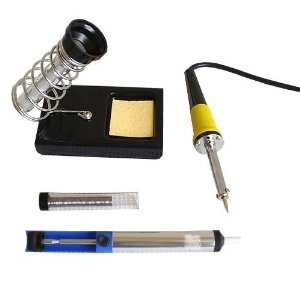
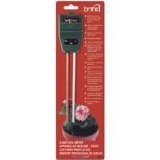
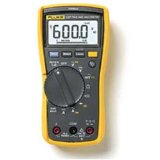

Search This Site
Search With Google
Soldering Kit Contents
Thirsty Light Garden Moisture Meters
Sometimes when you go out shopping you just happen to come across something that really appeals due to its simplicity and novelty Thirsty light meter
Moisture Meter Guide
The complete moisture meter website
When you go shopping for a soldering kit you will actually be quite surprised by how many there are out there for you to choose from. Depending upon the manufacturer the contents of the soldering kit may vary slightly. But ultimately each soldering kit will have the basic soldering tools you require.
There are specific soldering kits put together for specific uses. For example if you will be working with electrical wires al the time then these kits will include such things as wire cutters and strippers along with colour coding manuals and such.
However all soldering kits have a nucleus to them with the most essential soldering tools present. You can add to your kit with additional tools when and if required. But for the purpose of this site we shall just concentrate on the basic and essential requirements of the soldering kit. The essential contents are:
Soldering iron
SolderDesoldering tool
Tip cleaner
Flux
Moisture Meter Guide 2010 Contact details:garnett65@hotmail.com
The Orchid Moisture Meter
The orchid belongs to a widespread and very diverse family of flowering plants which have fragrant and colourful blooms. Orchids can be found in pretty much every habitat. Orchid health
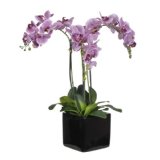
Firewood Moisture Meter
The Stihl moisture meter can be used to detect and give a moisture reading level in firewood. This is important if you have a log burning fire or stove. It is essential that you only burn well seasoned wood. As well as being able to detect the moisture levels in firewood the Stihl moisture meter can be used on both paper and cardboard as well.
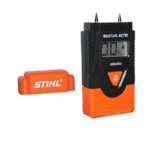
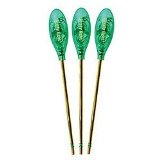
Hydroponic Moisture Meter
Hydroponics is a way of growing plants in water, using mineral nutrient solutions and no soil. Terrestrial plants can be grown using such mediums as gravel, mineral wool, expanded clay and rock wool. Hydroponic meter
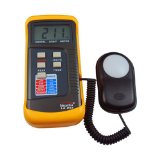
Soldering Advice
?
Flux
Flux is a chemical cleaning agent, flowing agent or a purifying agent. It can provide several functions at any given time and is used with soldering. When used in the process of soldering it’s main use is for that of preventing oxidization of the base and filler metals. When heated flux prevents the formation of metal oxides. So for example, tin lead solder attaches extremely well to copper. However this same solder works poorly with oxides of copper. So using flux can help with this issue. Flux also allows solder to flow more freely. Not in all soldering kits, flux is necessary and should be added.
Solder Iron
The solder iron is a handy tool that has a great number of valuable applications and is the most important part of any soldering kit. Basically the solder iron is used with a metal (solder) that has a low melting point and can be very easily used to join together other solid materials such as metal and glass. Solder usually consists of a combination of both lead and tin but there are other varieties of solder that do have different element mixture ratios. The solder used with a solder iron can also vary in size depending upon the project it is required for and of course the actual strength of bond that is needed.
Soldering with a solder iron, even though quite similar to brazing and welding with the intended results, is actually very different. It differs from brazing due to the metals used which have very low melting points.
And with welding the difference is that the 2 conjoining metals are not actually melted together, but merely connected through the same medium. But despite these differences the solder iron and the techniques used with it are definitely not limited to just one application.
Solder Iron Uses
The solder iron can be used in the electronic world as soldering can create a bond between two connecting materials without destroying those two materials. So with electronics, electricians are able to create conductive connections between sets of fragile wires or even work on circuit boards. The solder iron supplies the user with a tool that is more than capable of delicately connecting two metals without any danger of destroying any delicate parts on a circuit board for example.
Other similar delicate tasks that the solder iron can be used for include jewelry making and repair. Again because solder can be used to join two precious metals together without any damage, you find that every jeweler and jeweler repairer with have a solder iron or a soldering station in their workshops.
Within the plumbing industry, the solder iron can also be used and indeed is so to seal a space between two masses making it both waterproof and even permanent if need be. The solder iron has been used by plumbers for many years to seal copper piping that has sprung a leak. It has proved to be extremely reliable with plugging any leaks and in fact is actually strong enough to be an actual permanent solution. However if for some reason modification is required then the solder can be easily undone. This type of soldering with the solder iron is also perfect in the use and makings of stained glass windows or art pieces made from glass. With the solder iron a person can successfully join two pieces of coloured glass together with a thick soldered bond.
Essential Contents Of Any Soldering Kit
The soldering iron
The soldering iron is a small hand held tool that is ideal for working with fragile electronic parts or jewelery making and repair to mention just a couple of applications. The soldering iron is the main part of any soldering kit that you may be looking at to purchase. A soldering iron will run from a power range between 15 and 30 watts giving off temperatures up to 350 degrees. It is perfect for melting solder or other light metals in just a fraction of time. Because of its size and shape the soldering iron is ideal for working on precision jobs such as that of circuit boards or repairing precious jewelery.
There are many solder irons out there on the market today but we have just selected this one to show as an example. It is a Weller 12 Watt 240v soldering iron from Weller. Weller is a well known company in the soldering world and has a reputation for manufacturing high quality, durable and efficient goods for you to use with soldering. This Weller solder iron has been designed and manufactured with precision and accuracy in mind. When fully heated it has a temperature of 395 degrees and comes with a nickel plated tip.The handle has a thermo plastic coating to give the user comfort as well as a safe grip. All the connections on this tool are electronically and mechanically secure. All in all a very nice soldering iron to own and if any soldering kit you buy does contain a Weller solder iron you are definitely on the right road to selecting a high quality soldering kit.
The soldering gun
The soldering gun works on the same basis as a soldering iron but it is a bigger and more powerful tool. Depending upon which type of soldering you intend to embark on the soldering gun may be a better alternative for you, in which case you need a soldering kit that contains one of these solder guns. The solder gun is more powerful than a solder iron and has a power range of 100 to 240 watts with a heat output reaching up to 2400 degrees if so required. Perfect for larger jobs where you need to melt heavier solder or even have to cut through stronger metals.
Uses for these tools include sealing copper piping, the construction of glass windows and even cutting shapes out of steel. So when choosing a soldering kit make sure you are fully aware of the capabilities of both tools and the type of job you want the soldering kit for.
The picture is that of a Weller universal soldering gun that is fitted with a highly efficient copper soldering tip. It is a perfect tool for hobbies, model making and even major home repairs. The pistol grip has an instant heat fingertip trigger switch so once turned on you are ready to go with this tool.
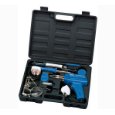
Soldering Kit
Each soldering kit is put together for specific and different applications. However the majority of soldering kits will contain the basic fundamental tools.
Anything you are not sure about soldering just check out the advice page.
Solder
Any form of soldering kit must have solder as one of it’s contents. Without solder you will not be able to do any soldering. Solder is a fusible metal alloy that has a melting point range of between 90 to 450 degrees and is used by melting it to join metallic surfaces together. It is widely used in the electronic world of circuit boards and even in the plumbing trade. The most used solder consists of alloys that melt between 180 and 190 degrees. Solder can contain lead and flux but in many applications these days the solder is actually lead free.The word solder comes from the old English word soudur which means to make solid.
Soldering Iron Tip Cleaner
When using a solder iron you need to keep the tip clean to ensure that you receive maximum working conditions. A good quality soldering kit will have a solder iron tip cleaner as one of it’s contents. This particular tip cleaner from Weltec consists of a metallic sponge that is 85% bronze and 15% steel. With this you need no longer have to moisture a cleaning sponge and because of this you are in the position of being able to efficiently clean your tip without the iron being cooled due to humidity. This tip cleaner is a useful accessory and has an elegant appearance as well. It comes with a very nice looking holder that has rubber support. The height of the unit is 4.5 cm with a diameter of 9 cm.
De Soldering Tool
Any decent soldering kit should contain a de soldering tool. There will be times that you have carried out soldering only to find that perhaps you are not so happy with the standard of work you have done. This happens to us all and inevitably you require to reverse the soldering process. To do this the perfect tool is a de soldering gun.
This Draper de soldering tool gives a good idea of the sort of tool you require to undo any soldering job. It has an aluminium body and can be used to suck up any surplus molten solder during both soldering jobs and disordering jobs. The molten solder is sucked up into the barrel of the tool when you press the operating button. Not expensive to purchase on it’s own, but a very useful tool to have when you are soldering. So make sure the soldering kit you choose does have one of these in it’s contents.
Above are a few examples of how the solder iron can be used. There are many more uses but each use will require a different size of solder and a different strength of solder iron. Jewelers and electricians will be using a less powerful solder iron in their soldering kit and smaller size of solder than the plumber for example. But all the basic principles and the methods of using the solder iron remain intact.
One use of the solder iron we forgot to mention was that within pyrography. This is the art of burning an image in to wood or plastic with the solder iron. This technique is also very crucial in some certain industries. But whatever your requirements from a solder iron one thing is for sure and that is if you buy a solder iron you are actually making a very good investment. The tool will serve you well in your preferred uses but you also will own an extremely versatile tool that will allow you to turn your attention to other skills and uses.
Choosing a solder iron
There are a few varieties of the solder iron for you to choose from, ranging from the wireless soldering tools such as the butane solder iron to the instant cool solder iron. Which ever one your choose to own is purely up to your own preferences and the purposes to which you will be applying your solder iron.
When deciding upon which solder iron is the right one for you to have in your soldering kit, there are a couple of considerations you must think about such as what will you be using the solder iron for, which type of heat will you require from your solder iron and will you be requiring portability or a fixed solder iron. These conditions when met will more or less determine the solder iron that you will invest in.
If the work you will be doing with the solder iron is mostly done at a service bench it might be a good idea for you to have a soldering station. As with most products on the market these days there are many versions and varieties to choose from. However you should really be looking for a soldering station that has adjustable power setting. This will give you many soldering irons in one and by having the station you will also have a place to quickly store your solder iron between uses. The downside to the soldering station is that you are limited in portability due to it’s size and the fact that you require an AC power supply. However if you only do bench work then the unit is ideal for you.
If you need a solder iron that gives you portability then you need look no further than at one of the versions of the quick cool solder iron. These particular solder irons do not require an AC power source and the batteries that these solder irons use will give you approximately 10 hours of power before needing to be recharged. On the downside though this type of solder iron does lack power and something around 10 watts does seem to be the norm in wattage power. They are suitable though for the smaller kind of jobs but if you need a solder iron to work with wire or larger components that are not heat sensitive then 10 watts of power is nowhere near enough ample power.
The solder iron and soldering guns than run off an AC power source are almost the complete package. They offer you a range of power options as well as giving you some portability as well. The soldering guns do give you a power supply ample enough to work with soldering wire and other large components. But unfortunately it is very difficult to get into very small areas with them. The solder iron though on the other hand give you a wide range of power sources as well as the flexibility to reach those hard to get to places. Another advantage of the solder iron is the ability to change tips. There is practically a changeable tip for the solder iron for every imaginable job out there.
Finally there are the butane solder irons which give the user the portability of a cordless solder iron, the choice of soldering tips and the necessary power you will need for most soldering jobs. You will need spare gas canisters when using one of these but all in all they do offer you an excellent alternative.
AS you can see there are a wide variety of the solder iron out there. So give some thought to what you actually require and when you have decided then pop down to your local DIY outlet or even shop in the comfort of your own home through the internet.
Solder Iron Vs Soldering Gun
Soldering is a technique that involves a high level of craftsmanship that has many applications both in industry and recreation. There are two main tools used for soldering and these are the solder iron and the solder gun. But what are the differences between the two?
The solder iron is a tool that is perfect for use with fragile electronic parts or jewelry manufacturing and repairing.
The solder iron runs off a power range of between 15-
The solder gun is a tool that is used where more heat is required than with a solder iron. The power range of a solder gun goes from 100 to 240 watts with a heat output of 2400 degrees being achieved if necessary. It is ideal for larger jobs that require melting much heavier solder or even cutting through stronger metals. Such uses include sealing copper piping, making glass windows and even cutting shapes out of steel.
Both tools serve the same function though, just to different degrees of ability based on their output power levels. This just goes to show the variety of uses that soldering can be applied to.
Soldering Gun
The soldering gun, an alternative to the soldering iron in a soldering kit, is a hand held tool that is used to solder metals together. With a soldering gun you will use a tin based solder in order to obtain a conductive contact between the two metals. The soldering gun has the form of a pistol and it’s trigger style switch enables it to be easily used with just one hand. Inside the body of the soldering gun there is a transformer with a secondary element. The soldering tip of the soldering gun is usually made out of copper wire and is fixed to the end of the transformer by screws. When the switch is activated the soldering gun heats the copper tip through several hundred amps of electric current.
The main reason for selecting a soldering gun over a soldering iron to add to your soldering kit, is that you require more heat for the specific application you are working on. The average soldering gun is rated between 100 and 240 watts and they are ideal to use with heavy electrical connections, stained glass window work and any light sheet metal work. Certain soldering guns will have 2 stage triggers to enable the user two different heat settings. When you buy a soldering gun you can also buy one that comes with tips which can be used for the cutting and shaping of plastic.
You can also use a soldering gun to solder small surface mounted device components when you replace the thick default wire with a thinner one. By bending the wire loop of the soldering gun in to a rectangular shape you will be able to solder 14 and 16 pin SMD packages by heating all the pins at the same time. This job can be done in about 10 seconds and shows the versatility of the soldering gun and its wire tip.
The looped wire tip shape of the soldering gun has other advantages as well. The tip can be shaped or turned to be able to get in to confined spaces. This is not possible with many soldering irons that have the regular coned shape tip. When it comes to controlling the temperature of a soldering gun, this is done by holding the button until the solder melts and then releasing the button. When you see that the solder is beginning to solidify, you simply press the button again and apply heat. After a little use with a soldering gun you will master the application of heat and this technique.
One problem facing the soldering gun is the fact that the copper wire loop will actually slowly dissolve in solder over time. This does mean that you will have to replace the loop wire on a regular basis. Also the soldering gun does produce a lot of heat which means that it can not be used on circuit boards and other such delicate applications. But despite these couple of negatives, the soldering gun does prove to be an excellent addition to any soldering kit.
How A Soldering Gun Works
The soldering iron and soldering gun basically perform the same task of supplying heat to melt and apply solder, yet there are differences between the two. The soldering gun is designed for intermittent use whereas the soldering iron is designed to remain hot for long periods of time. The soldering gun uses a transformer to convert 110 AC to a lower voltage. The soldering iron uses fine windings of resistance wire to generate it’s heat.
A soldering gun has a trigger which you need to depress to start the heating process. Once the switch has been depressed the heating process will begin. The low voltage current will then flow through the tip which reaches operating heat in about 10 seconds or so. The majority of soldering guns will have an indicator light which comes on when the trigger is depressed and this light also gives added visibility qualities when the soldering application is taken on. The soldering iron on the other hand is on as soon as you plug it in. And it will remain on until you unplug it.
When the soldering gun has reached it’s operating temperature, solder is then applied to the copper tip. This cleans the tip as well as having the tool ready for the job in hand. The tip is then applied to both materials that you wish to solder together and additional solder is applied to the materials rather than to the tip of the soldering gun.
You will know when the correct soldering temperature has been reached because the solder will flow freely. A good and successful solder joint will have flat edges and be shiny. Solder has a habit of free flowing towards the heat source so when you are soldering two flat pieces of metal the solder will flow towards the tip. Capillary action will then draw the solder to the immediate joint as long as you have the correct heat temperature.
Uses For A Soldering Gun
The soldering gun is a hand held tool that uses it’s heat to melt materials such as solder and stained glass lead. However this is not all the soldering gun can be used for as it proves itself to be a rather versatile tool. It can be used on other materials such as plastic and wood. Because the soldering gun has interchangeable tips, it is not solely used with solder.
Electronics
Probably the most frequent task undertaken with a soldering gun is that of soldering wires in electronics. In this case the particular model you will use will be dependent upon the type of solder you use. Lead based materials will melt at lower temperatures whereas lead free materials will require a higher heat.
Welding
The soldering gun can be used to weld small pieces of metal together, such as steel. The solder you will require for this type of job must be rated to the job in hand for the weld to hold. Lead free solders must be used for sheet metals in order for the join to hold.
Stained Glass
A soldering gun is used to melt solder between glass pieces to hold the glass together. The temperature of the soldering gun needs to be kept even in this application so that the solder remains at a set consistency.
Working With Plastic
The soldering gun can be used to either cut or shape plastic. The tip will get hot enough to melt even the heaviest of plastics. You can also weld plastic with the soldering gun by melting the edges of the 2 pieces of plastic.
Wood Burning
With the soldering gun you can also burn designs in to wood. The soldering iron is the preferred tool for this application, but because the soldering gun has interchangeable tips, different lines and designs can be burned in to the wood.
Soldering Gun Working Tips
Preparation is all important. Take some wire wool and always clean the soldering gun before use. The same should be done with the materials that are to be soldered.
Heat up the items to be soldered. By doing this the solder will flow effectively in to the joint. Do not apply too much solder and do not overheat the materials to be soldered.
The trigger activates the soldering gun. Always wait for it to reach optimum heat before using it. Also do not release the trigger until you have cleared the tip from the solder joint. If you do then you may find that the strength of the joint could be affected.
Always keep the soldering gun away from your body. Gloves need to worn and you must avoid breathing in any fumes that are created by wearing a protective face mask of some sort. When the soldering gun is not in use always keep it turned off.
Desoldering Pump
A desoldering pump is a small soldering tool that is used to remove any unwanted solder from a work area such as a circuit board. The desoldering pump may also be referred to as a solder sucker and comes in 2 variations. The types of desoldering pump are the plunger style or the bulb type.
The plunger version of the disordering pump is a small spring loaded tool that can suck up any solder from a connection or surface. It works in a similar fashion as to that of a syringe. A user will activate this plunger desolderer by the way of a switch or button and places it to the heated solder that needs to be removed. Other models of the plunger pump will use a vacuum pump as opposed to the spring to create a vacuum in which to suck up the targeted solder.
The bulb style desoldering pump also works in the same manner as the plunger style, but instead the bulb is used to create a vacuum as opposed to the spring. And this technology has been applied to the disordering iron which is basically a soldering iron with a disordering bulb attached to it.
How To Use A Desoldering Pump
If you are familiar with soldering then you will know that it can be rather intricate. Unfortunately there will be times when you solder incorrectly and need to reverse the process. Thanks to the desoldering pump that you have in your soldering kit, this reverse step can be taken quickly and efficiently.
To use the disordering pump to remove unwanted solder you will at first need to reheat
the solder. You will do this with your soldering iron. To de-
What Is Desoldering?
Desoldering is the removal of unwanted or misplaced solder. When soldering a person may mistakenly use too much solder or indeed solder a wrong component. To save the circuit board or whatever the job is, desoldering will do this. Basically desoldering is heating up unwanted solder and removing it using some form of desoldering tool. These tools can be pump or wicks.
There are several specialized tools, materials and techniques that have all been designed to help with the desoldering process in order to protect circuit boards, components and electrical equipment whilst the desoldering takes place.
Solder Wick
A solder wick is a roll of fine braided AWG wire. This wire is usually made out of oxygen free copper and then treated with a rosin solder flux. It is extremely easy to use and gives great results even in the most delicate of situations.
The way to use solder wick correctly is to place the solder wick over the solder that you wish to remove. You then take your soldering iron and heat the part of the wick that is in contact with the solder. The solder wick will heat up and this in turn will heat the solder. What happens next is when the solder begins to melt it is sucked in to the solder wick via capillary action. Once the solder is sucked up you remove the solder wick and heat source from where you are working. The removed solder will solidify within the wick away from your work piece. You can then discard the used section of solder wick and place the rest of the solder wick back in your soldering kit until you require it again.
| Tramex Moisture Encounter Plus |
| Tramex Compact Wood Moisture Meter |
| Tramex Concrete Encounter Moisture Meter |
| Tramex Skipper Plus Moisture Meter |
| Tramex Roof And Wall Moisture Scanner |
| Sonin Digital Moisture Meter model 50218 |
| Sonin Digital Moisture Meter 270 model 50270 |
| Sonin Moisture Test Tool model 50210 |
| Sonin Moisture Test Meter Model 50211 |
| Oak |
| Douglas Fir |
| Beech Tree |
| Elm Tree |
| Hickory Tree |
| Maple Tree |
| Pine Tree |
| Prevent And Repair Gaps In Wooden Floorboards |
| How To Fix A Squeaky Hardwood Floor |
| How To Repair A Hardwood Floor That Has Buckled |
| Which Is The Best Firewood? |
| Concrete |
| Concrete Moisture |
| Screed Moisture Meter |
| SDS Drill |
| Belle Cement Mixer |
| SDS Drill Advice |
| Which SDS Drill |
| SDS Drill Accessories |
| Drilling Into Concrete |
| Kennedy Tool Box |
| Moisture - Basic Facts |
| Types Of Damp |
| Wet Rot |
| Dry Rot |
| Mold |
| Water Leak Detection |
| Stucco Moisture |
| Water Damage |
| Moisture And Rust |
| Moisture Damage To A Chimney |
| Wallpaper Stripper |
| Plaster Mixer |
| Why Worry About Moisture Problems |
| Does Your Home Have A Moisture Problem? |
| How To Solve Moisture Problems |
| How To Use Anti Mold Paint |
| Rising Damp |
| Condensation |
| Salt Damp |
| How To Avoid Bathroom Condensation |
| How To Remove Black Mold |
| How To Prevent Bathroom Mold |
| Soldering Kit |
| Soldering Kit Contents |
| Soldering Kit Advice |
| Bonsai Tree Classification |
| Growing Bonsai From Seed |
| Bonsai Tree Care |
| Bonsai Tree Training |
| Bonsai Tools |
| Displaying Bonsai |
| Bonsai Calendar |
| Bonsai Plants |
| The Thirsty Light Curve Moisture Meter |
| The Thirsty Light Ladybird Moisture Meter |
| The Thirsty Light Bumble Bee Moisture Meter |
| The Thirsty Light Butterfly Moisture Meter |
| Hanna Instruments |
| Agratronix Portable Coffee Moisture Tester |
| Lawn Aerator |
| Lawn Roller |
| Lawn Rake |
| Lawn Sand |
| Chainshot |
| Chainsaw Gloves |
| Chainsaw Trousers |
| Chainsaw Boots |
| Mac 4 - 20 XT Chainsaw |
| Mac 738 Chainsaw |
| Mac 842 Chainsaw |
| Mac 20X Power Chainsaw |
| Einhell BG-PC 3735 Chainsaw |
| Einhell BG-PC 4040 Chainsaw |
| Einhell BG-PC 5045 Chainsaw |
| Poulan P3314 Chainsaw |
| Poulan P4018 Chainsaw |
| Poulan Pro PP3816AV Chainsaw |
| Poulan Pro PP4218AVX Chainsaw |
| Poulan Pro PP4620AVX Chainsaw |
| Efco MT 4100 SP Chainsaw |
| Efco MT 3500 Chainsaw |
| Efco 132 S Chainsaw |
| Efco 147 Chainsaw |
| Efco 152 Chainsaw |
| Efco MT 7200 Chainsaw |
| Efco MT 8200 Chainsaw |
| Efco MT 3750 Chainsaw |
| Methods Of Obtaining Soil Moisture Levels |
| Hygrometer |
| Psychrometer |
| Rain Gauge |
| Wave Ventilation System |
| Humidity |
| Hygrometer For Keeping Reptiles |
| Humidor |
| Weather Stations |
| Musical Instrument Storage |